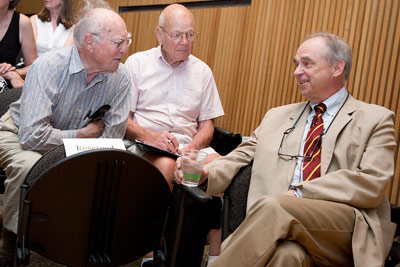Doug Antczak '69 entertains alumni with (some true!) tales of hybrids and chimeras
By Kate Engler

Fantastic creatures composed of parts of different animals, including humans, were common in mythology, and their imprint remains in our consciousness today. With our current understanding of evolutionary processes and capacity to change the genetic makeup of organisms, some of those myths are coming closer to reality, said Doug Antczak '69, the Dorothy Havemeyer McConville Professor of Equine Medicine at Cornell's Baker Institute for Animal Health, June 9.
Cornell Library's Reunion lecture, "Hybrids and Chimeras, Real and Imagined: Crossing Forbidden Boundaries in the Animal Kingdom," given by Antczak, is the second in a series of lectures celebrating the exhibition, "Animal Legends: From the Trojan Horse to Godzilla" at the Carl A. Kroch Library.
Antczak's lecture covered a broad swath, ranging from the selection of desired traits in domesticated species to the use of gene therapy to cure inherited diseases in animals and humans. Several of the examples he cited were landmark research studies previously undertaken or currently under way at Cornell.
Hybrid animals and plants, Antczak explained, are a blend of each organism's parents and in many ways can be better than either parent. For example, the mule, the first genetically engineered animal, is stronger than its donkey father, more disease-resistant than its horse mother and lives longer than either parent.
Lesser-known examples of hybrids, some of which have occurred naturally, include the "zorse," a horse and zebra mix, the "leopons," a lion and leopard mix, and a "cama," a camel and llama mix. The successful production of the cama is significant, Antczak pointed out, because the camel and llama are separated by 20 million years of evolution.
Humans, too, are hybrids of Homo sapiens and Neanderthals, Antczak told the audience, pointing to a study that concluded that about 1-4 percent of the human genome is made up of Neanderthal genes. Some humans have more or fewer Neanderthal genes, depending from where their ancestors originated. For example, no evidence for Neanderthal genes has been found in DNA samples from Africans.
"This project is a good illustration of what one might call a 'my wife is right' study -- I probably am a bit of a Neanderthal," Antczak quipped, as he asked the audience to speculate about the percentage of Neanderthal genes likely to be found in people they know, including fellow Cornell alumni.
Unlike hybrids, which frequently occur naturally, chimeras, such as the mythological centaur, pegasus and satyr, are rare. However, there are certain situations in which a type of chimera can be formed, he said. For example, if a dairy cow has twins with conjoined circulation, a small percentage of each calf's blood type can be that of its co-twin. Chimeras such as these helped to define the mechanisms that produce immunological tolerance, Antczak said. In addition, sheep and goat chimeras have been created by mixing sheep and goat embryos, forming an animal with distinctly sheep and goat body parts.
Even Cornell has had its share of chimeras, Antczak said, presenting a video of the "unimal," created by Professor Howard Babcock in the 1950s. The unimal was an invented creature made up of a sheep, cow, steer, chicken and pig that eventually became a toy; it was meant to teach students about the importance of agriculture and using animal products.
Graduate student Kate Engler is a writer intern for the Cornell Chronicle.
Media Contact
Get Cornell news delivered right to your inbox.
Subscribe